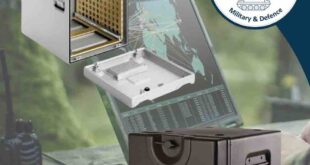Dave Beckstoffer compares and contrasts the different stepper motor technologies
The latest developments in stepper motor design not only increase the benefits over brushless DC motors in many applications, but also offer improved performance to address a broader range of tasks that were once the sole province of servomotors.
From machine tools to medical equipment and a host of different applications in between, stepper motors are frequently the preferred choice of motor where precise and predictable positioning in a compact, cost-effective package is required.
Popularised in the 1960s as their many advantages became ever clearer, their increased adoption has been driven over the years by advances in integrated circuit technology, making the stepper drive electronics easy to realise.
This has seen design engineers turn to stepper motors where they might previously have used a more conventional brushless DC motor or opted for a servomotor.
The stepper motor offers a simpler solution for achieving high levels of repeatability, without the need for a feedback device, as well as high holding torque.
When compared against servomotors, the stepper motor solution is typically significantly less expensive while offering near equivalent positioning accuracy, making it an ideal alternative in cost-sensitive applications.
As advances in stepper motor technology continue, the very latest developments mean their advantages extend beyond just cost and simplicity.
Most recently, we have seen advances in the conceptual design of stepper motors, extending their range of applications further into servo territory, based not only on cost but also on genuine performance advantages.
Principles of operation
To understand these design developments, let’s first review the stepper motor’s principle of operation and the different stepper motor technologies. The stepper motor is itself, of course, a type of brushless DC (BLDC) motor, but with a key conceptual difference.
Unlike a standard BLDC motor, where position control is accomplished using a feedback transducer such as an encoder or a resolver, in the stepper motor rotation is divided into a fixed number of individual steps. The number of steps per revolution depends on the number of phases and the number of pole pairs. A high number of commutations per revolution results in a high number of steps per revolution.
Stepper motors can be divided into two basic groups: the first one works without a permanent magnet, the second one uses a permanent magnet located in the rotor. Variable reluctance (VR) motors form the first group, whereas the second comprises the original permanent magnet (PM) motor, the hybrid motor and the disc magnet motor.
VR motors were favoured historically for their capability of having a high number of steps per revolution, and therefore a greater inherent positioning accuracy capability.
However, by introducing ‘microstepping’ (the process of driving a stepper motor at less than one full step per movement) in other designs of stepper motor, engineers have voided this advantage. VR motors cannot be driven in microstepping mode and they do not have the performance attributes to compare with other stepper technologies in other areas.
All of the disadvantages of VR steppers are addressed in PM motor designs, at a lower cost of manufacture and with improved performance. While it is true that they cannot achieve as small a step angle, this can be mitigated in PM stepper motors with a drive that can operate in microstepping mode.
Suppose, though, we could combine the strengths of both designs and eliminate the weaknesses? This is the hybrid stepper motor. Like PM motors, they contact a permanent magnet in the rotor teeth, and like VR motors they have stator poles. These will physically modify the airgap as the rotor moves, and therefore the inductance of the phase winding changes with rotor position.
The result is a motor that offers small steps (allowing a simpler drive technology to be used), increased output torque and quiet operation. However, these advantages do come at a cost, meaning hybrid stepper motors are more costly than either VR or PM stepper motors. This cost should be factored in during specification to determine whether the long term performance improvement will add enough value to justify the premium.
Disc magnet technology
Evaluating the different stepper motor technologies, what becomes clear is that the ideal solution would be a PM design that could have a high number of poles and a better magnetic circuit. Could this be possible?
Back in the 1960s, the development of quartz-controlled watches required a new type of stepper motor to drive the hands. It had to be small and very efficient.
With rare earth magnets becoming available, Portescap used these materials to develop a single-phase stepper motor with a “thin disc magnet rotor”.
Subsequently used in many millions of watches, this ‘2-phase disc magnet stepper motor’ was presented to the world in 1981 for more general automation applications.
Today, taking advantage of developments in rare earth magnet materials, Portescap offers disc magnet motors that provide exceptional dynamic performance unparalleled by other stepper motor technologies. The rotor consists of a rare earth magnet having the shape of a thin disc which is axially magnetized.
The magnetisation method allows for a high number of magnetic poles, giving much smaller step angles than conventional two-phase PM stepper motors.
A very low moment of inertia results in outstanding acceleration and dynamic behaviour. These features, together with high peak speeds, mean that any incremental movement is carried out in the shortest possible time. The low inertia also means high start/stop frequencies which save time during the first step and solve certain motion problems without applying a ramp.
Torque is uniform, and many control and/or positioning schemes rely upon this linearity for their success – for instance, microstepping and closed-loop operation. Further, there are no harmonic distortions. Why is this important? The torque-displacement curves of stepper motors are supposed to be sinusoids. Pure sinusoids mean better accuracy when positioning in the microstepping mode of operation where sine and cosine ratios are used. They also mean no inherent linearity as positioning current is varied from zero to maximum, so ensuring a consistent torque constant.
Overlapping capabilities
The result of the latest advances in disc magnet stepper motor technology is that the application boundaries between steppers, BLDC motors and servomotors are blurring more than ever. With their increased torque, disc magnet stepper motors can provide extremely accurate, stiff performance at low speeds without a gearbox or other type of mechanical advantage.
The low inertia of disc magnet stepper motors enables them to achieve high torque output and higher speeds, up to 10,000 rpm without the traditional fall-off in torque.
It is true that the cost of servomotors has fallen, but even so, a stepper system will be significantly cheaper, with disc magnet stepper motors offering near servo performance beyond the typical range of applications for steppers. If an application has predictable loads, a disc magnet stepper can move them with high repeatability and reliability.
Ultimately, the choice of the most appropriate motor technology for a given application will come down to a host of different design parameters. However, with the line between the different motor technologies now hazier than ever, the latest disc magnet stepper motors give design engineers new options to improve performance, reduce size and save costs.
Image 1: The rotor of a disc magnet motor consists of a rare earth magnet having the shape of a thin disc which is axially magnetised
Dave Beckstoffer is Business Development Manager at Portescap.
 Engineer News Network The ultimate online news and information resource for today’s engineer
Engineer News Network The ultimate online news and information resource for today’s engineer





